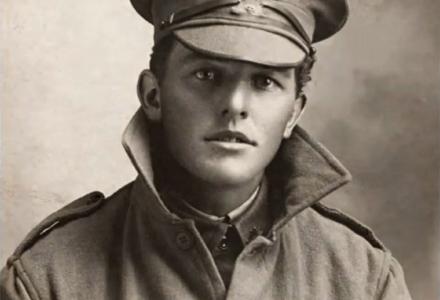In July 1916, as the British offensive on the Somme ground to a halt, Australian forces were ordered to attack at Pozières. The town was taken at a terrible cost. Unable to retake it, the Germans pounded the position with shells. The bombardment of Pozières was one of the heaviest artillery barrages of the war. Men were driven mad by the deafening roar of it. After three days, the 1st Division suffered over five thousand casualties. Then the 2nd Division was thrown into the fighting. Bert Crowle, a former architect from Adelaide, had been an officer little more than a fortnight. He was ordered to lead his men in an attack on a German stronghold, Mouquet Farm.
All of the officers in the 10th Battalion were hit. Lieutenant Crowle was caught by machine gun fire in the early stages of the advance. Stretcher bearers carried him to safety. It was a slow and agonising journey over four miles of battered open ground. An unarmed soldier waving a red flag walked at the head of the party. Not a single German soldier fired on them.
The surgeons at the casualty clearing station cut pounds of flesh away from the wounded man’s buttocks. Infection set in a few days later. With the aid of a chaplain, drifting in and out of consciousness, Bert composed a final letter to his wife and his son: ‘Dearest Beat and Bill. Just a line you must be prepared for the worst to happen any day. It is no use trying to hide things…’
Bert told his family he was in agony, that gangrene had taken hold, and that there was little chance they could save him. ‘Tomorrow I shall know the worst as the dressing was to be left on for three days and tomorrow is the third day it smells rotten. … The doctor gave me some morphia which eased me a little but the pain is getting worse and worse’.
Lieutenant Bert Crowle died the next day. He was buried in Punchvillers British Cemetery, not far from the ruined village, on the gentle hills of the Somme.
Beatrice received her husband's final letter several weeks after the curt telegram announcing his death. Obituaries to Bert were placed in the Adelaide press every August for years to come, grim milestones in a long journey of bereavement. At the end of the war, with considerable trouble and no small expense, Beatrice arranged for a sturdy stone monument to be set on the grave. The inscription she chose echoed the distant grief of a family in Australia, and the longing of community that felt the loss of one of its own.
Erected in loving memory by his wife and brother
October 1919
From Adelaide Australia
He Gave His All
Most private memorials were removed after the war and replaced by the regulation War Commission tombstones. Partly it was a way of ensuring uniformity. To this day the neatly aligned headstones stand proudly on their manicured lawns, like so many soldiers marshalled on a parade ground. But replacing private memorials was also a way of ensuring all would be honoured equally. Between senior officer and private soldier, rich and poor no distinction would be made. It is an irony that the British Empire, steeped in age-old privilege, should preside over this democracy of the dead.
For some reason that has escaped any record in the archives, War Graves Units and then the War Graves Commission left the Crowle family’s final tribute in its place. It stands there to this day, a grey granite outcrop stranded in a sea of white tombstones.
Crowle’s story reminds us of the arbitrary nature of war. In the firing line, it seemed a matter of chance if a soldier lived or died—some were wounded multiple times, others survived the war unscathed. Chance also shaped the fashions of commemoration. In the post war years, the Imperial War Graves Commission struggled to impose order of a fractured landscape. But in the hastily established battlefield graveyards one still sees a trace of the chaos of wartime: The rows of unknowns, the co-mingled graves, and a tombstone that connected a family to France.
For full attribution of sources, suggestions for further reading and an extended version of the story itself see ‘A man who stood out: Bert Crowle’ in Bruce Scates, Rebecca Wheatley and Laura James, World War One: A History in 100 stories (Melbourne, Penguin/Viking, 2015) pp. 68-69; 357.



